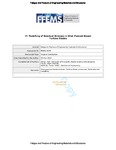Finite element modelling of residual stresses in shot‐peened steam turbine blades
| dc.contributor.author | Newby, M | |
| dc.contributor.author | James, MN | |
| dc.contributor.author | Hattingh, DG | |
| dc.date.accessioned | 2015-11-19T16:20:08Z | |
| dc.date.available | 2015-11-19T16:20:08Z | |
| dc.date.issued | 2014-07 | |
| dc.identifier.issn | 8756-758X | |
| dc.identifier.issn | 1460-2695 | |
| dc.identifier.uri | http://hdl.handle.net/10026.1/3823 | |
| dc.description.abstract |
<jats:title>ABSTRACT</jats:title><jats:p>The attachment region in steam turbine blades is critical to structural integrity, and hence, surface treatment by shot peening or roller burnishing is commonly used to induce compressive residual stresses in the fir‐tree region of the blade. In particular, the last stage blades on the low pressure rotors present the highest risk in terms of catastrophic failure due to their size and operating conditions. These blades have a mass of some 24 kg and operate in a wet steam environment at approximately 60 °C while rotating at 3000 rpm; potential failure modes include high and low cycle fatigue, stress corrosion cracking and corrosion fatigue. This paper reports the development of, and results obtained from, an elastic‐perfectly plastic finite element model of the residual stresses in the attachment region of a last stage blade and the influence on these compressive stresses of fatigue cycling. The model uses thermal quenching to simulate the residual stress profile obtained in the fir‐tree serrations after shot peening. Results were validated via extensive synchrotron and laboratory X‐ray diffraction measurements of the residual stress in shot‐peened specimens.</jats:p> | |
| dc.format.extent | 707-716 | |
| dc.language | en | |
| dc.language.iso | en | |
| dc.publisher | Wiley | |
| dc.subject | FE modelling | |
| dc.subject | residual stresses | |
| dc.subject | steam turbine blades | |
| dc.subject | fatigue | |
| dc.subject | shot peening | |
| dc.title | Finite element modelling of residual stresses in shot‐peened steam turbine blades | |
| dc.type | journal-article | |
| dc.type | Article | |
| plymouth.author-url | https://www.webofscience.com/api/gateway?GWVersion=2&SrcApp=PARTNER_APP&SrcAuth=LinksAMR&KeyUT=WOS:000337593700003&DestLinkType=FullRecord&DestApp=ALL_WOS&UsrCustomerID=11bb513d99f797142bcfeffcc58ea008 | |
| plymouth.issue | 7 | |
| plymouth.volume | 37 | |
| plymouth.publication-status | Published | |
| plymouth.journal | Fatigue & Fracture of Engineering Materials & Structures | |
| dc.identifier.doi | 10.1111/ffe.12165 | |
| plymouth.organisational-group | /Plymouth | |
| plymouth.organisational-group | /Plymouth/Faculty of Science and Engineering | |
| plymouth.organisational-group | /Plymouth/Faculty of Science and Engineering/School of Engineering, Computing and Mathematics | |
| plymouth.organisational-group | /Plymouth/Users by role | |
| plymouth.organisational-group | /Plymouth/Users by role/Academics | |
| dc.rights.embargodate | 2015-07-01 | |
| dc.identifier.eissn | 1460-2695 | |
| dc.rights.embargoperiod | 12 months | |
| rioxxterms.versionofrecord | 10.1111/ffe.12165 | |
| rioxxterms.licenseref.uri | http://www.rioxx.net/licenses/under-embargo-all-rights-reserved | |
| rioxxterms.type | Journal Article/Review |


